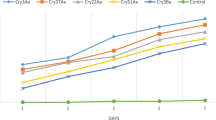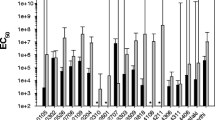Abstract
The genes cry1Ac and cry1Ca from Bacillus thuringiensis subsps. kurstaki HD-73 and aizawai 4J4, respectively, encoding δ-endotoxins against lepidopteran larvae were isolated, cloned and expressed in Escherichia coli, with and without cyt1Aa (encoding cytolytic protein) and p20 (accessory protein) from subsp. israelensis. Nine combinations of the genes under control of an early T7, P A1 inducible promoter, produced the encoding proteins. Toxicities were examined against larvae of three major agricultural pests: Pectinophora gossypiella, Helicoverpa armigera and Spodoptera littoralis. The clones expressing cyt1Aa, with or without p20, were not toxic. The clone expressing cry1Ac (pBt-1A) was the most toxic to P. gossypiella (LC50 of 0.27 × 108 cells g−1). Clone pBt-1CA expressing cry1Ca and cry1Ac displayed the highest toxicity (LC50 of 0.12 × 108 cells ml−1) against S. littoralis. Clone pBt-1CARCy expressing all four genes (cry1Ca, cry1Ac, p20, cyt1Aa) in tandem exhibited the highest toxicity to H. armigera (LC50 of 0.16 × 108 cells ml−1). Cyt1Aa failed to raise the toxicity of these Cry toxins against P. gossypiella and S. littoralis but significantly enhanced toxicity against H. armigera. Two additional clones expressing either cry1Ac or cry1Ca under tandem promoters, P A1 and P psbA (constitutive), displayed significantly higher toxicities (7.5- to 140-fold) than their counterparts with P A1 alone, reducing the LC50 values to below 107 cells ml−1.




Similar content being viewed by others
References
Angsuthanasombat C, Crickmore N, Ellar DJ (1992) Comparison of Bacillus thuringiensis subsp. israelensis CryIVA and CryIVB cloned toxins reveals synergism in vivo. FEMS Microbiol Lett 94:63–68
Aronson AI (1995) The protoxin composition of Bacillus thuringiensis insecticidal inclusions affects solubility and toxicty. Appl Environ Microbiol 61:4057–4060
Berry C, O`Neil S, Ben-Dov E, Jones AF, Murphy L, Quail MA, Holden M, Harris D, Zaritsky A, Parkhill J (2002) Complete sequence and organization of pBtoxis, the toxin-coding plasmid of Bacillus thuringiensis subsp. israelensis. Appl Environ Microbiol 69:2415–2422
Brixey PJ, Guda C, Daniell H (1997) The chloroplast psbA promoter is more efficient in Escherichia coli than the T7 promoter for hyperexpression of a foreign protein. Biotechnol Lett 19:395–399
Butko P (2003) Cytolytic toxin Cyt1A and its mechanism of membrane damage: data and hypotheses. Appl Environ Microbiol 69:2415–2422
Cao J, Zhao J-Z, Tang JD, Shelton AM, Earle ED (2002) Broccoli plants with pyramided cry1Ac and cry1C Bt genes control diamondback moths resistant to Cry1A and Cry1C proteins. Theor Appl Genet 105:258–264
Crickmore N, Bone EJ, Williams JA, Ellar DJ (1995) Contribution of the individual components of the δ-endotoxin crystal to the mosquitocidal activity of Bacillus thuringiensis subsp. israelensis. FEMS Microbiol Lett 131:249–254
Deuschle U, Kammerer W, Gentz R, Bujard H (1986) Promoters of Escherichia coli: a hierarchy of in vivo strength indicates alternate structures. EMBO J 5:2987–2994
Douek J, Einav M, Zaritsky A (1992) Sensitivity to plating of Escherichia coli cells expressing the cytA gene from Bacillus thuringiensis subsp. israelensis. Mol Gen Genet 232:162–165
Escriche B, de Decker N, van Rie J, Jansens S, van Kerkhove E (1998) Changes in permeability of brush border membrane vesicles from Spodoptera littoralis midgut induced by insecticidal crystal proteins from Bacillus thuringiensis. Appl Environ Microbiol 64:1563–1565
Estela A, Baltasar E, Ferré J (2004) Interaction of Bacillus thuringiensis Toxins with Larval Midgut Binding Sites of Helicoverpa armigera (Lepidoptera: Noctuidae). Appl Environ Microbiol 70:1378–1384
Federici BA, Bauer LS (1998) Cyt1Aa protein of Bacillus thuringiensis is toxic to the cottonwood leaf beetle, Chrysomela scripta, and suppresses high levels of resistance to Cry3Aa. Appl Environ Microbiol 64:4368–4371
Ferré J, Van Rie J (2002) Biochemistry and genetics of insect resistance to Bacillus thuringiensis. Ann Rev Entomol 47:501–533
Fortier M, Vachon V, Marceau L, Schwartz JL, Laprade R (2007) Kinetics of pore formation by the Bacillus thuringiensis toxin Cry1Ac. Biochim Biophys Acta 1768:1291–1298
Georghiou GP, Wirth MC (1997) Influence of exposure to single versus multiple toxins of Bacillus thuringiensis subsp. israelensis on development of resistance in the mosquito Culex quinquefasciatus (Diptera: Culicidae). Appl Environ Microbiol 63:1095–1101
Gonzáles-Cabrera J, Farinós GP, Caccia S, Díaz-Mendoza M, Castañera P, Leonardi MG, Giordana B, Ferré J (2006) Toxicity and mode of action of Bacillus thuringiensis Cry proteins in the Mediterranean corn bore, Sesamia nonagrioides (Lefebvre). Appl Environ Microbiol 72:2594–2600
Gould F, Anderson A, Reybolds A, Baumgarber L, Moar WJ (1995) Selection and genetic analysis of a Heliothis virescens (Lepidoptera: Noctuidae) strain with high levels of resistance to some Bacillus thuringiensis toxins. J Econ Entomol 88:1545–1559
Herrero S, Gechev T, Bakker PL, Moar WJ, de Maagd RA (2005) Bacillus thuringiensis Cry1Ca-resistant Spodoptera exigua lacks expression of one of four Aminopeptidase N genes. BMC Genomics 6:96
Khasdan V, Ben-Dov E, Manasherob R, Boussiba S, Zaritsky A (2001) Toxicity and synergism in transgenic Escherichia coli expressing four genes from Bacillus thuringiensis subsp. israelensis. Environ Microbiol 3:798–806
Khasdan V, Ben-Dov E, Manasherob R, Boussiba S, Zaritsky A (2003) Mosquito larvicidal activity of transgenic Anabaena PCC 7120 expressing toxin genes from Bacillus thuringiensis subsp. israelensis. FEMS Microbiol Lett 227:189–195
Kouskoura T, Tickner C, Crickmore N (2001) Expression and crystallization of an N-terminally activated form of the Bacillus thuringiensis Cry1Ca toxin. Curr Microbiol 43:371–373
Liao C, Heckel DG, Akhurst R (2002) Toxicity of Bacillus thuringiensis insecticidal proteins for Helicoverpa armigera and Helicoverpa punctigera (Lepidoptera: Noctuidae), major pests of cotton. J Invertebr Pathol 80:55–66
Ludwig M, Becker N (1997) Studies on possible resistance against Bacillus thuringiensis israelensis in Aedes vexans (Diptera, Culicinae) after 15 years of application. Zool Beitr 38:167–174
Manasherob R, Zaritsky A, Ben-Dov E, Saxena D, Barak Z, Einav M (2001) Effect of accessory proteins P19 and P20 on cytolytic activity of Cyt1Aa from Bacillus thuringiensis subsp. israelensis in Escherichia coli. Curr Microbiol 43:355–364
Manceva SD, Pusztai-Carey M, Russo PS, Butko P (2005) A detergent like mechanism of action of the cytolytic toxin Cyt1A from Bacillus thuringiensis var. israelensis. Biochemistry 44:589–597
Maqbool SB, Riazuddin S, Loc NT, Gatehouse AMR, Gatehouse JA, Christou P (2001) Expression of multiple insecticidal genes confers broad resistance against a range of different rice pests. Mol Breed 7:85–93
Margalith Y, Ben-Dov E (2000) Biological Control by Bacillus thuringiensis subsp. israelensis. In: Rechcigl JE, Rechcigl NA (eds) Insect pest management: techniques for environmental protection. CRC Press LLC, Boca Raton, pp 243–301
Meyer SK, Tabashnik BE, Liu Y-B, Wirth MC, Federici BA (2001) Cyt1A from Bacillus thuringiensis lacks toxicity to susceptible and resistant larvae of diamondback moth (Plutella xylostella) and pink bollworm (Pectinophora gossypiella). Appl Environ Microbiol 67:462–463
Moar WJ, Pusztai-Carey M, Van Faassen H, Bosch D, Frutos R, Rang C, Luo K, Adang MJ (1995) Development of Bacillus thuringiensis Cry1C resistance by Spodoptera exigua (Hübner) (Lepidoptera: Noctuidae). Appl Environ Microbiol 61:2086–2092
Pérez C, Fernandez LE, Sun J, Folch JL, Gill SS, Soberón M, Bravo A (2005) Bacillus thuringiensis subsp. israelensis Cyt1Aa synergizes Cry11Aa toxin by functioning as a membrane-bound receptor. Proc Natl Acad Sci USA 102:18303–18308
Rang C, Bes M, Lullien-Pellerin V, Wu D, Federici BA, Frutos R (1996) Influence of the 20-kDa protein from Bacillus thuringiensis ssp. israelensis on the rate of production of truncated Cry1C proteins. FEMS Microbiol Lett 141:261–264
Rang C, Bergvingson D, Bohorova N, Hoisington D, Frutos R (2004) Competition of Bacillus thuringiensis Cry1 toxins for midgut binding sites: a basis for the development and management of transgenic tropical maize resistant to several stemborers. Curr Microbiol 49:22–27
Reddy ST, Kumar NS, Venkateswerlu G (1998) Comparative analysis of intracellular proteases in sporulated Bacillus thuringiensis strains. Biotechnol Lett 20:279–281
Rincón-Castro MC, Barajas-Huerta J, Ibarra JE (1999) Antagonism between Cry1Ac1 and Cyt1A1 toxins of Bacillus thuringiensis. Appl Environ Microbiol 65:2049–2053
Sambrook J, Russell DW (2001) Molecular cloning: a laboratory manual, 3rd edn. Cold Spring Harbor Laboratory Press, Cold Spring Harbor
Sayyed A, Haward R, Herrero S, Ferré J, Wright DJ (2000) Genetic and biochemical approach for characterization of resistance to Bacillus thuringiensis toxin Cry1Ac in a field population of the diamondback moth, Plutella xylostella. Appl Environ Microbiol 66:1509–1516
Sayyed A, Crickmore N, Wright DJ (2001) Cyt1Aa from Bacillus thuringiensis subsp. israelensis is toxic to the diamondback moth, Plutella xylostella, and synergizes the activity of Cry1Ac towards a resistant strain. Appl Environ Microbiol 67:5859–5861
Schnepf E, Crickmore N, Van Rie J, Lereclus D, Baum J, Feitelson J, Zeigler DR, Dean DH (1998) Bacillus thuringiensis and its pesticidal crystal proteins. Microbiol Mol Biol Rev 62:775–806
Shao Z, Liu Z, Yu Z (2001) Effects of the 20-Kilodalton helper protein on Cry1Ac production and spore formation in Bacillus thuringiensis. Appl Environ Microbiol 67:5362–5369
Shelton AM, Tang JD, Roush RT, Metz TD, Earle ED (2000) Field tests on managing resistance to Bt-engineered plants. Nat Biotechnol 18:339–342
Soltes-Rak E, Kushner DJ, Williams DD, Coleman JR (1993 Effect of promoter modification on mosquitocidal cryIVB gene expression in Synechococcus sp. strain PCC 7942. Appl Environ Microbiol 59:2404–2410
Tabashnik BE (1994) Evaluation of resistance to Bacillus thuringiensis. Ann Rev Entomol 39:47–49
Tabashnik BE, Finson N, Groeters FR, Moar WJ, Johnson MW, Luo K, Adang MJ (1994) Reversal of resistance to Bacillus thuringiensis in Plutella xylostella. Proc Natl Acad Sci USA 91:4120–4124
Tabashnik BE, Liu Y-B, de Maagd RA, Dennehy TJ (2000) Cross-resistance of pink bollworm (Pectinophora gossypiella) to Bacillus thuringiensis toxins. Appl Environ Microbiol 66:4582–4584
Ward ES, Ellar DJ (1986) Bacillus thuringiensis var. israelensis δ-endotoxin nucleoide sequence and characterization of the transcripts in Bacillus thuringiensis and Escherichia coli. J Mol Biol 191:1–11
Wirth MC, Georghiou GP, Federici BA (1997) Cyt1Aa enables CryIV endotoxins of Bacillus thuringiensis to overcome high levels of CryIV resistance in the mosquito, Culex quinquefasciatus. Proc Natl Acad Sci USA 94:10536–10540
Wirth MC, Walton WE, Federici BA (2000a) Cyt1Aa from Bacillus thuringiensis restores toxicity of Bacillus sphaericus against resistant Culex quinquefasciatus (Diptera: Culicidae). J Med Entomol 37:401–407
Wirth MC, Federici BA, Walton WE (2000b) Cyt1Aa from Bacillus thuringiensis synergizes activity of Bacillus sphaericus against Aedes aegypti (Diptera: Culicidae). Appl Environ Microbiol 66:1093–1097
Wirth MC, Walton WE, Manasherob R, Khasdan V, Ben-Dov E, Boussiba S, Zaritsky A (2003) Larvicidal activities of transgenic Escherichia coli against susceptible and Bacillus thuringiensis israelensis-resistant strains of Culex quinquefasciatus. IOBC/WPRS Bull 27:171–176
Wirth MC, Jiannino JA, Federici BA, Walton WE (2005) Evolution of resistance toward Bacillus sphaericus or a mixture of B. sphaericus + Cyt1A from Bacillus thuringiensis, in the mosquito, Culex quinquefasciatus (Diptera: Culicidae). J Invertebr Pathol 88:154–162
Wu D, Johnson JJ, Federici BA (1994) Synergism of mosquitocidal toxicity between CytA and CryIVD proteins using inclusions produced from cloned genes of Bacillus thuringiensis. Mol Microbiol 13:965–972
Wu X, Vennison SJ, Liu H, Ben-Dov E, Zaritsky A, Boussiba S (1997) Mosquito larvicidal activity of transgenic Anabaena strain PCC 7120 expressing combinations of genes from Bacillus thuringiensis subsp. israelensis. Appl Environ Microbiol 63:1533–1537
Xue J-L, Cai Q-X, Zheng D-S, Yuan Z-M (2005) The synergistic activity between Cry1Aa and Cry1C from Bacillus thuringiensis against Spodoptera exigua and Helicoverpa armigera. Lett Appl Microbiol 40:460–465
Zhao J-Z, Fan YL, Fan XL, Shi XP, Lu MG (1999) Evaluation of transgenic tobacco expressing two insecticidal genes to delay resistance development of Helicoverpa armigera. Chin Sci Bull (English edition) 44:871–1874
Zhao J-Z, Cao J, Li Y, Collins HL, Roush RT, Earle ED, Shelton AM (2003) Transgenic plants expressing two Bacillus thuringiensis toxins delay insect resistance evolution. Nat Biotechnol 21:1493–1497
Acknowledgments
The authors thank Michael Davidovich, Svetlana Kontsedalov and Sophia Kleitman from the Agricultural Research Organization (ARO), and Monica Einav of BGU’s Life Sciences Department, for their technical assistance. Aaron Leeper from the ARO, Gilat is gratefully acknowledged for his valuable editorial comments. This investigation was partially supported by grants of the Chief Scientist of the Israel Ministry of Agriculture (No. 857-0481-03 to AZ, RH and SB) and from the United States-Israel Binational Science Foundation (B.S.F.), Jerusalem, Israel (AZ and SB) (No. 2001-042).
Author information
Authors and Affiliations
Corresponding author
Additional information
Communicated by Jan Roelof van der Meer.
Vadim Khasdan and Maria Sapojnik are contributed equally to this work.
Rights and permissions
About this article
Cite this article
Khasdan, V., Sapojnik, M., Zaritsky, A. et al. Larvicidal activities against agricultural pests of transgenic Escherichia coli expressing combinations of four genes from Bacillus thuringiensis . Arch Microbiol 188, 643–653 (2007). https://doi.org/10.1007/s00203-007-0285-y
Received:
Revised:
Accepted:
Published:
Issue Date:
DOI: https://doi.org/10.1007/s00203-007-0285-y




